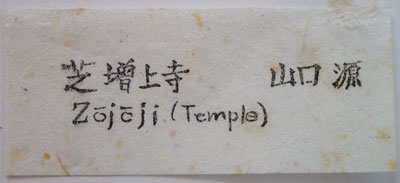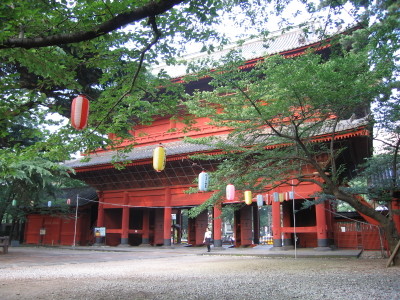About This Print
One of fifteen prints from the 1945 series Scenes of Last Tokyo. This print was one of seven new designs for the series, the other eight prints originally appearing in the 1929-1932 series Shin Tokyo hyakkei (One Hundred Views of New Tokyo).Zōjōji Temple History
Source: Zozoji website http://www.zojoji.or.jp/en/index.htmlZōjōji was founded in 1393 as an orthodox and fundamental nembutsu1 seminary for Jodo shu2 in the Kanto (east Japan) region.
Zōjōji was relocated to the present site in 1598 after Ieyasu Tokugawa,founder of the Tokugawa shogunate, entered Edo (present-day Tokyo) in1590 to establish his provincial government. After the start of the EdoPeriod when the Tokugawa shogunate ruled Japan, Zōjōji became thefamily temple of the Tokugawa family and an unparalleled grandcathedral was built. Zōjōji also served as an administrative center togovern the religious studies and activities of Jodo shu. In those days,its precincts covered an area of 826,000 square meters which alsocontained 48 smaller attached temples and about 150 grammar schools.Moreover, as many as 3,000 priests and novices always resided here asstudents.
Nevertheless, as theTokugawa shogunate came to an end and the Meiji Era started, ananti-Buddhist movement got under way. The cathedral, temples and themausoleum of the Tokugawa family were burned down by air raids duringWorld War II. Thus, Zōjōji was profoundly affected by political andsocial circumstances. Today, however, its cathedral and otherstructures have been rebuilt, and Zōjōji continues to serve as the maintemple of Jodo shu and the central nembutsu seminary for priests andnovices. Furthermore, it has endeared itself to the general public asboth a grand Buddhist temple typical of the metropolis Tokyo and a hubof religious and cultural activities.
 Label from original folio Label from original folio芝増上寺 山口源 |  |
1 The word literally means "buddha in mind" and it has come to meanverbal recitation of the words "I take refuge in Amitabha Buddha" inone language or another.
2 Jōdo shū (浄土宗, "The Pure Land School"), also known as Jodo Buddhism, is a branch of Pure Land Buddhism derived from the teachings of the Japanese ex-Tendai monk Hōnen. It was established in 1175 and is the most widely practiced branch of Buddhism in Japan, along with Jodo Shinshu.
Print Details
| IHL Catalog | #120 |
| Title | Zōjōji Temple in Shiba 芝増上寺 Shiba Zōjōji |
| Series | Scenes of Last Tokyo [also seen translated as Recollections of Tokyo] 東京回顧図会 Tokyo kaiko zue |
| Artist | Yamaguchi Gen (1896-1976) |
| Signature | unsigned |
| Seal | artist's seal "Gen" |
| Publication Date | December 1945 |
| Edition | likely first edition |
| Publisher | Fugaku Shuppansha 富岳出版社, Tokyo, Uemura Masurō 上村益郎 publisher |
| Printer | Hirai Kōichi 平井孝一 |
| Impression | excellent |
| Colors | excellent |
| Condition | good - random printers ink in left and bottom margins; tape remnants on corners of top margin verso from previous mounting in original non-archival presentation folder |
| Genre | sosaku hanga (creative print) |
| Miscellaneous | |
| Format | chuban |
| H x W Paper | 7 3/4 x 10 3/4 in. (19.7 x 27.3 cm) |
| H x W Image | 7 1/8 x 9 3/8 in. (18.1 x 23.8 cm) |
| Collections This Print | Los Angeles County Museum of Art M. M.81.267.28; Carnegie Museum of Art 89.28.709.15; Mead Art Museum at Amherst College AC 2008.63.9; Smithsonian Freer Gallery of Art and Arthur M. Sackler Gallery S1995.118.1; Portland Art Museum 1996.31.2i |
| Reference Literature | The Artist's Touch, The Craftsman's Hand: Three Centuries of Japanese Prints from the Portland Art Museum, Maribeth Graybill, Portland Art Museum, Oregon, 2011, p. 299; Made in Japan: The Postwar Creative Print Movement, Alicia Volk, Milwaukee Art Museum, 2005, p. 35; Modern Japanese Prints: The Twentieth Century, Amanda T. Zehnder, Carnegie Museum of Art, 2009, p. 182 |


